《中考新突破》2016年中考英语(云南版)精讲课件:专题十二 简单句 (共41张PPT)
文档属性
| 名称 | 《中考新突破》2016年中考英语(云南版)精讲课件:专题十二 简单句 (共41张PPT) | 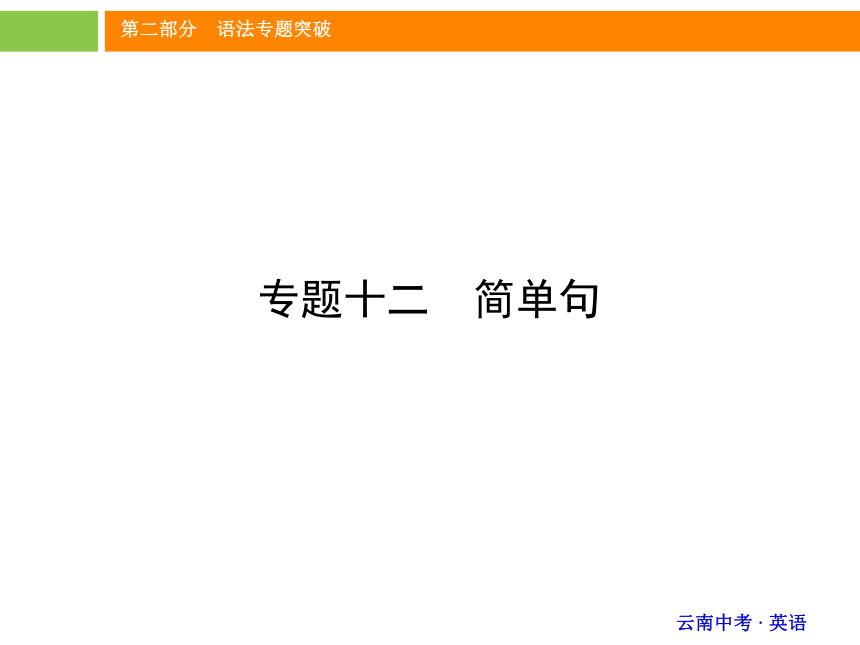 | |
| 格式 | zip | ||
| 文件大小 | 634.8KB | ||
| 资源类型 | 教案 | ||
| 版本资源 | 通用版 | ||
| 科目 | 英语 | ||
| 更新时间 | 2016-05-10 21:22:44 | ||
图片预览

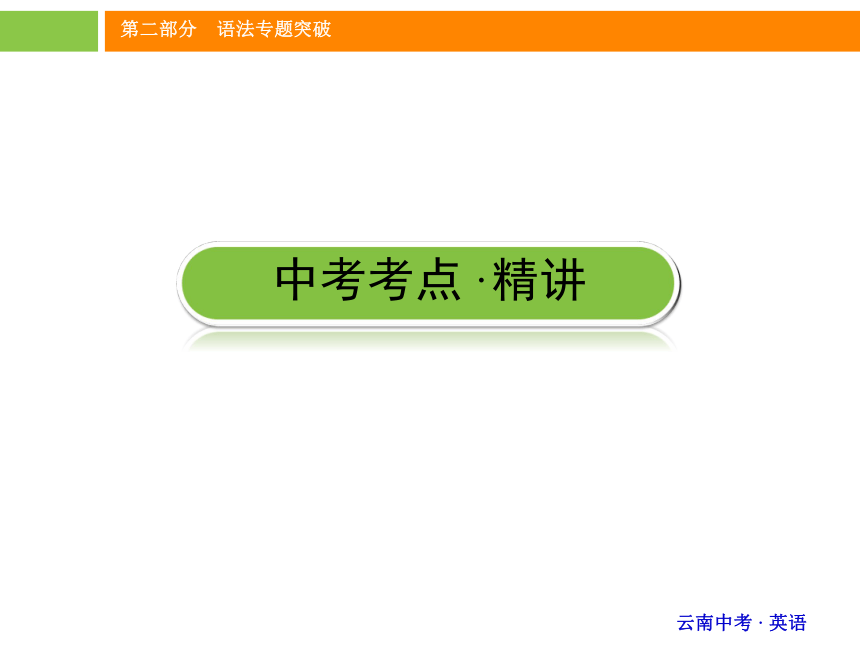
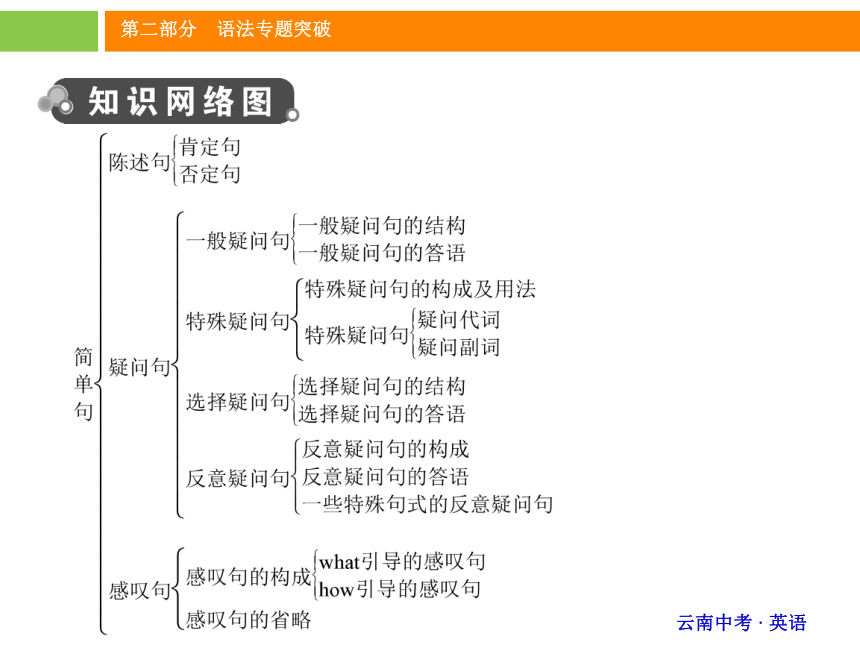
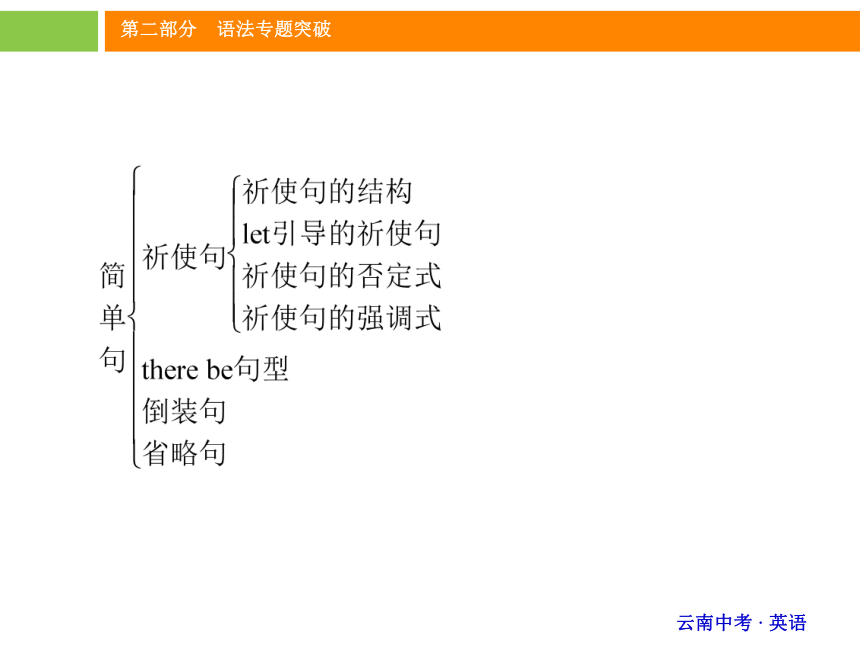
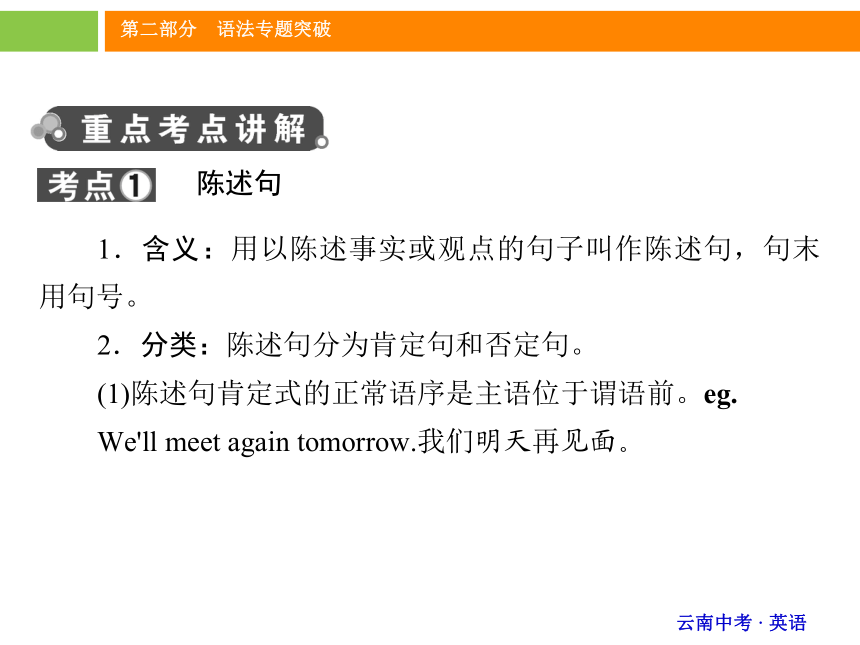

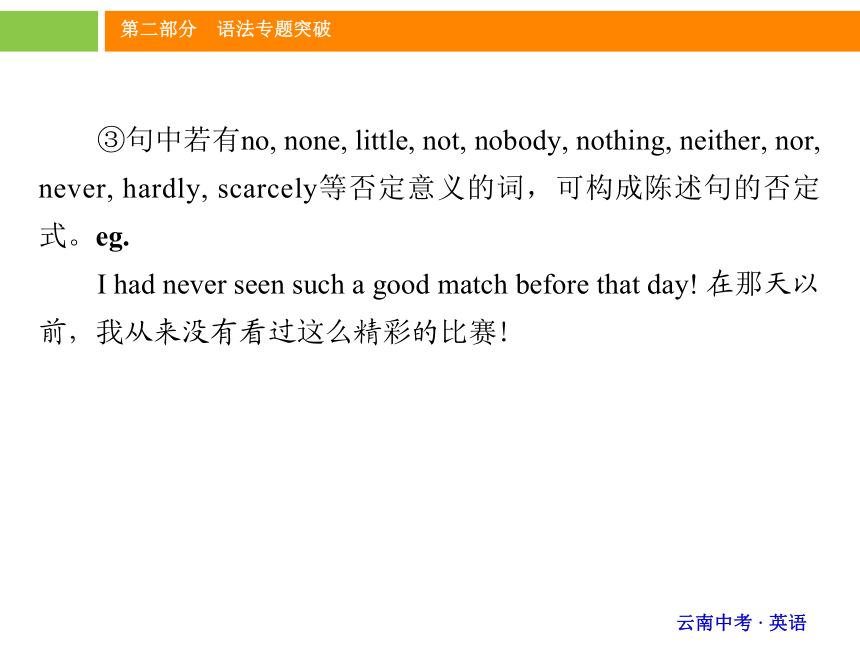
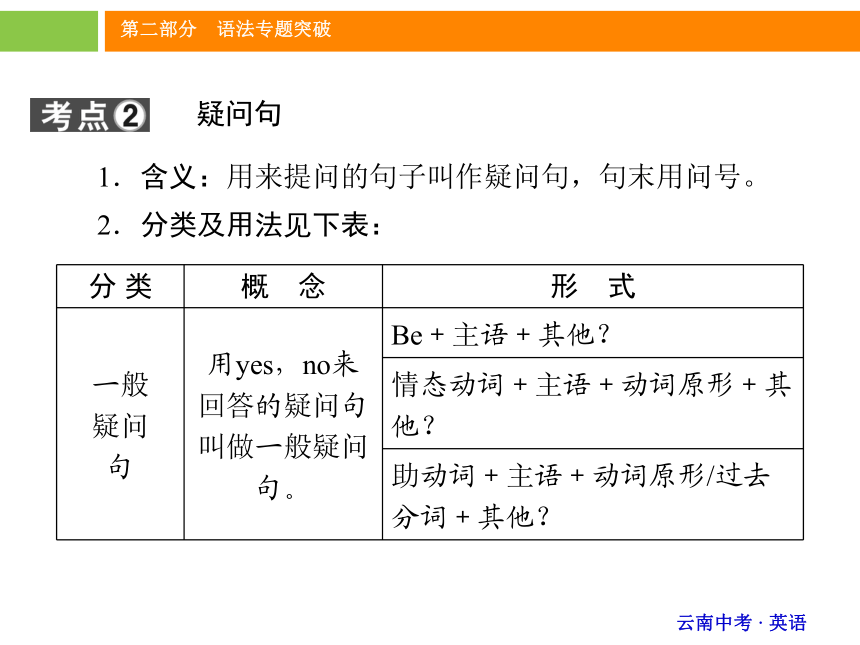
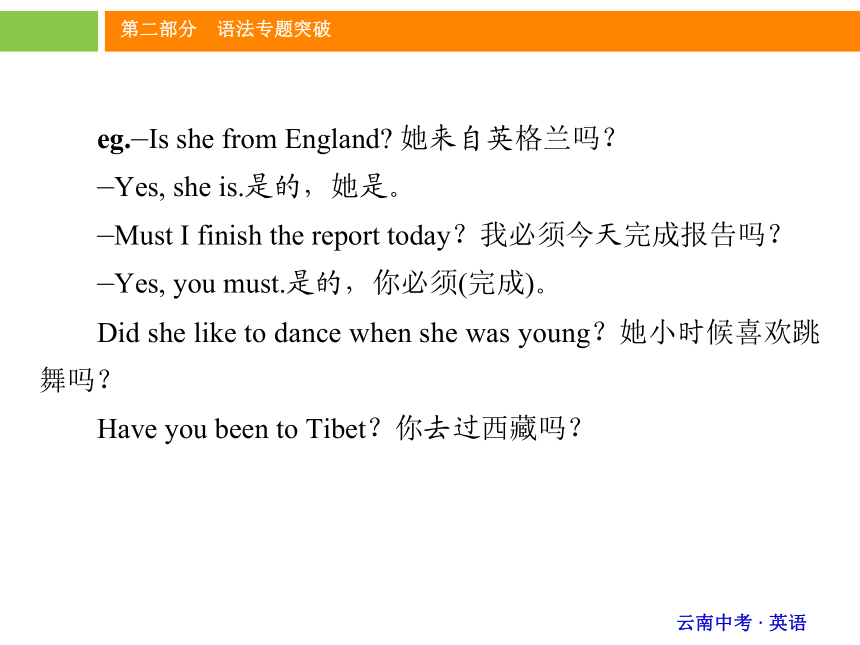
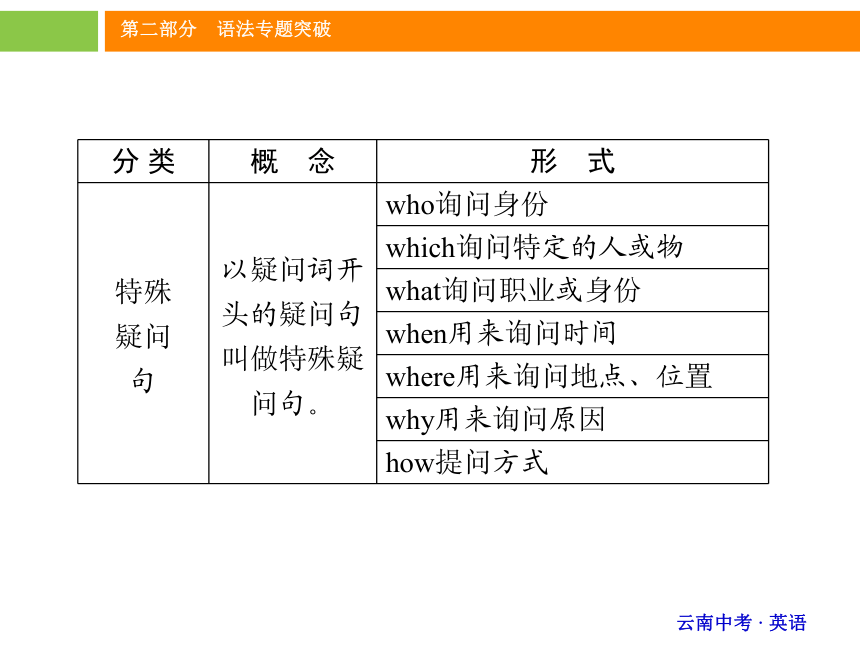
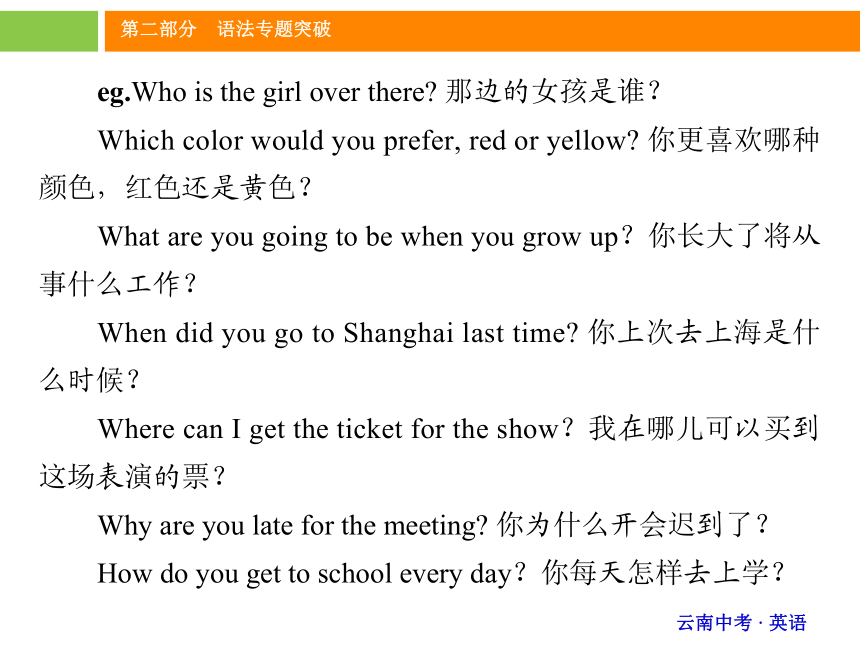
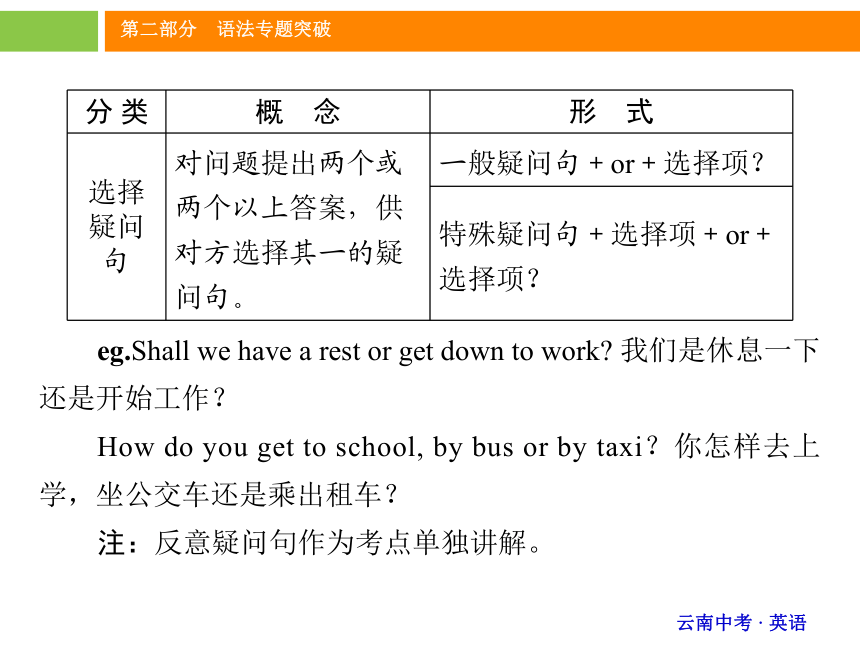
文档简介
课件41张PPT。专题十二 简单句1.含义:用以陈述事实或观点的句子叫作陈述句,句末用句号。
2.分类:陈述句分为肯定句和否定句。
(1)陈述句肯定式的正常语序是主语位于谓语前。eg.
We'll meet again tomorrow.我们明天再见面。 陈述句
(2)陈述句否定式的结构
①含有be动词,助动词have, will和情态动词的否定形式是将not放在这些词的后面。eg.
We mustn't waste any more time.我们绝不能再浪费时间了。
②实义动词的否定形式要借助于助动词,并且将否定词not加在助动词的后面。eg.
I didn't find Chinese easy at first.起初,我发现学中文不容易。
③句中若有no, none, little, not, nobody, nothing, neither, nor, never, hardly, scarcely等否定意义的词,可构成陈述句的否定式。eg.
I had never seen such a good match before that day! 在那天以前,我从来没有看过这么精彩的比赛!1.含义:用来提问的句子叫作疑问句,句末用问号。
2.分类及用法见下表: 疑问句
eg.—Is she from England? 她来自英格兰吗?
—Yes, she is.是的,她是。
—Must I finish the report today?我必须今天完成报告吗?
—Yes, you must.是的,你必须(完成)。
Did she like to dance when she was young?她小时候喜欢跳舞吗?
Have you been to Tibet?你去过西藏吗?eg.Who is the girl over there? 那边的女孩是谁?
Which color would you prefer, red or yellow? 你更喜欢哪种颜色,红色还是黄色?
What are you going to be when you grow up?你长大了将从事什么工作?
When did you go to Shanghai last time? 你上次去上海是什么时候?
Where can I get the ticket for the show?我在哪儿可以买到这场表演的票?
Why are you late for the meeting? 你为什么开会迟到了?
How do you get to school every day?你每天怎样去上学?eg.Shall we have a rest or get down to work? 我们是休息一下还是开始工作?
How do you get to school, by bus or by taxi?你怎样去上学,坐公交车还是乘出租车?
注:反意疑问句作为考点单独讲解。中考常考与how有关的疑问词的用法辨析:1.反意疑问句中主语及谓语的确定
(1)陈述部分谓语是系动词、助动词或情态动词时,附加问句重复这些词。eg.
She is a university student, isn't she?她是一位大学生,不是吗?
Young John can't dress himself, can he?小约翰自己不会穿衣服,是吗? 反意疑问句 (2)陈述部分谓语是实义动词时,附加问句要用相同时态的助动词。eg.
The students enjoyed themselves at the party, didn't they? 学生们在聚会上玩得很开心,不是吗?
(3)陈述部分含有never, few, little, nothing, nobody, no, hardly, none, too... to...等表示否定意义的词时,其附加问句应用肯定形式。eg.
There are few people in the room, are there? 房间里几乎没有人,是吗?
She is too young to go to school, is she?她太小了而不能去上学,是吗?
(4)陈述部分是There be结构时,附加问句要用“be there”。eg.
There is a tree in front of the building, isn't there? 大楼前面有一棵树,不是吗?
(5)当陈述部分的主语为不定代词something, anything, everything等时,附加问句的主语应用it。eg.
Something is wrong with your computer, isn't it?你的电脑出毛病了,不是吗?
(6)当陈述部分的主语为指人的不定代词somebody, anybody, everybody 等时,附加问句的主语可用he或they,但不可用it来代替。eg.
Somebody wants to see you, doesn't he?有人要见你,不是吗?
(7)当陈述部分的主语为this, that等时,附加问句的主语应用it。类似地,当陈述部分的主语为these, those等时,附加问句的主语应用they。同时,陈述部分为肯定形式时,附加问句应用否定形式,反之亦然。eg.
This is a beautiful picture, isn't it?这是一幅美丽的图画,不是吗?
Those aren't apple trees, are they? 那些不是苹果树,是吗?(8)当陈述部分含有need时,如果need用作行为动词,则附加问句的谓语动词应用do(does);如果need用作情态动词,则附加问句的谓语动词应用need。eg.
We need to arrive in Shanghai at 7:00, don't we?我们需要在七点到达上海,不是吗?
We needn't leave at once, need we?我们不必马上离开,是吗?
(9)当陈述部分为I am形式时,附加问句应该用aren't I。eg.
I'm right, aren't I? 我是对的,不是吗?(10)肯定祈使句的附加问句可以用will you或won't you, 否定祈使句的附加问句用will you。 eg.
Listen to me carefully, will you? 仔细听我说,好吗?
Don't play with fire, will you? 不要玩火,好吗?
(11)以let's 开头的祈使句,附加问句应用shall we;以let us开头的祈使句,附加问句应用will you。eg.
Let's go to the park, shall we? 让我们去公园,好吗?
Let us help you, will you? 让我们来帮你,好吗?
2.反意疑问句的答语
对反意疑问句作回答时,如果答案是肯定的,则用yes,后跟肯定形式的简略回答;如果答案是否定的,则用no,后跟否定形式的简略回答。即其回答方式与一般疑问句的回答方式完全一致。特别注意有时要根据具体的语境确定用肯定形式还是否定形式来回答。eg.
—Lucy skates very well, doesn't she? 露西滑冰滑得非常好,不是吗?
—Yes, she does. 是的,她滑得很好。
—No, she doesn't. 不,她滑得不好。
—You don't like the man, do you? 你不喜欢这个男人,是吗?
—No, I don't. 是的,我不喜欢。
—Yes, I do. 不,我喜欢。反意疑问句用法口诀
前肯后否是习惯,前否后肯也常见。
尾句not如出现,必须缩写是习惯。,还有一点需注意,短语代词作主语。,回答反意疑问句,答案含义是依据。,肯定事实用yes,否定事实用no替。
注意:反意疑问句的构成应该是“肯定的陈述句+否定的疑问”或“否定的陈述句+肯定的疑问”;在短句中not必须与do, will, can等组成缩写形式;在简短问句中,疑问句的主语必须是代词,而不能用名词形式。 感叹句 陈述句变感叹句用法口诀
陈述句述事实,感叹句表感情。
陈述变成感叹句,主谓系表先分清。
宾语状语移句首,表语亦须打头阵。
名词之前用what,形副之前how先行。
复数名词无冠词,事先分析莫轻心。
如果名词不可数,摒弃a,an不留情。
冠词a,an要分明,清音辅音是标准。
句子结构要完整,标点符号亦变更。
总结规律进步快,编个歌诀给你听。 1.句式结构 祈使句
2.应答祈使句时要用将来时 eg.
—Please remember to take the dog out for a walk every day. 请记住每天带着狗散步。
—Yes, I will.好的,我会的。
—Don't take your mobile phone to school. 不要把手机带到学校来。
—Sorry, I won't.对不起,我不会了。
3.“祈使句+and/or+结果状语”结构 eg.
Work harder, and you'll get good grades. 再努力一把,你就会取得好成绩。
Hurry up, or you'll be late for class.快点,不然上课就要迟到了。
1.“there+be+sb/sth+地点”表示“某处有某人或某物”。be动词必须和主语保持人称和数的一致。如果主语部分是两个以上的并列主语时,be一般和邻近主语的数和人称保持一致,即遵循“就近原则”。eg.
There is some bread and turkey slices on the table. 桌上有些面包和火鸡肉片。
There are two books and a ping-pong bat in my backpack. 我背包里有两本书和一个乒乓球拍。 there be句型 2.There be句型的否定和疑问形式:
否定:There be not…(将来时:There will not be…/There is/are not going to be…)
一般疑问句:Be there…?(将来时:Will there be…?Is/Are there going to be…?)
答语:Yes, there be./No, there be not.(将来时:Yes, there will/is/are./No, there won't/isn't/aren't.)反意疑问句:There be…, be not there?(将来时:There will be…, won't there? 或 There is/are going to be…, isn't/aren't there?)
eg.
There are some interesting pictures in the book. 这本书里有一些有趣的图片。
→否:There aren't any interesting pictures in the book.
→疑:Are there any interesting pictures in the book?
→反意疑问句:There are some interesting pictures in the book, aren't there?
There is going to be a concert tomorrow.明天将有一场音乐会。
→否:There isn't going to be a concert tomorrow.
→疑:Is there going to be a concert tomorrow?
→反意疑问句:There is going to be a concert tomorrow, isn't there? 倒装句
注意:若对前面所说的事实加以肯定时,应用“so+主语+助动词/系动词/情态动词”。前后两个句子的主语为同一个人或物。eg.
—He likes English. 他喜欢英语。
—So he does.的确如此。
2.副词引导的倒装句
在以here, there, out, in, down, away等表示方位的副词开头的句子中,如果主语是名词时,要用倒装语序。因此谓语动词的形式由位于倒装句句尾的主语决定。eg.
There goes the bell.铃响了。
Here is a flower. 这有一朵花。
注意:如果主语是人称代词,则不用倒装。eg.
Here you are.给你。倒装句用法口诀
副词开头要倒装,人称代词则如常。
only修饰副介状,位于句首半倒装。
否定意义副连词,“既不……也不”须倒装。
表语前置主语长,衔接自然常倒装。
such代词作表语,引起主谓要倒装。
Not only开头句,前一分句须倒装。
had, were, should虚拟句,省略if半倒装。 云南中考只涉及了两类省略句:1.Me, too.“我也是”。2.Me, neither.“我也不是。”
1.“Me, too.”为非正式用语,口语上使用较多,正式的用法有时可以用so的倒装句来表示。eg.
—I'd like some cakes and a cup of coffee.我想要些蛋糕和一杯咖啡。
—Me, too.我也是。 省略句
2.“Me, neither.”相当于“Neither/ Nor+助动词(情态动词和系动词be)+主语.” eg.
—I haven't seen the film yet. 我还没有看过这部电影。
—Me, neither. /Neither have I. 我也没看过。谢谢观看!
2.分类:陈述句分为肯定句和否定句。
(1)陈述句肯定式的正常语序是主语位于谓语前。eg.
We'll meet again tomorrow.我们明天再见面。 陈述句
(2)陈述句否定式的结构
①含有be动词,助动词have, will和情态动词的否定形式是将not放在这些词的后面。eg.
We mustn't waste any more time.我们绝不能再浪费时间了。
②实义动词的否定形式要借助于助动词,并且将否定词not加在助动词的后面。eg.
I didn't find Chinese easy at first.起初,我发现学中文不容易。
③句中若有no, none, little, not, nobody, nothing, neither, nor, never, hardly, scarcely等否定意义的词,可构成陈述句的否定式。eg.
I had never seen such a good match before that day! 在那天以前,我从来没有看过这么精彩的比赛!1.含义:用来提问的句子叫作疑问句,句末用问号。
2.分类及用法见下表: 疑问句
eg.—Is she from England? 她来自英格兰吗?
—Yes, she is.是的,她是。
—Must I finish the report today?我必须今天完成报告吗?
—Yes, you must.是的,你必须(完成)。
Did she like to dance when she was young?她小时候喜欢跳舞吗?
Have you been to Tibet?你去过西藏吗?eg.Who is the girl over there? 那边的女孩是谁?
Which color would you prefer, red or yellow? 你更喜欢哪种颜色,红色还是黄色?
What are you going to be when you grow up?你长大了将从事什么工作?
When did you go to Shanghai last time? 你上次去上海是什么时候?
Where can I get the ticket for the show?我在哪儿可以买到这场表演的票?
Why are you late for the meeting? 你为什么开会迟到了?
How do you get to school every day?你每天怎样去上学?eg.Shall we have a rest or get down to work? 我们是休息一下还是开始工作?
How do you get to school, by bus or by taxi?你怎样去上学,坐公交车还是乘出租车?
注:反意疑问句作为考点单独讲解。中考常考与how有关的疑问词的用法辨析:1.反意疑问句中主语及谓语的确定
(1)陈述部分谓语是系动词、助动词或情态动词时,附加问句重复这些词。eg.
She is a university student, isn't she?她是一位大学生,不是吗?
Young John can't dress himself, can he?小约翰自己不会穿衣服,是吗? 反意疑问句 (2)陈述部分谓语是实义动词时,附加问句要用相同时态的助动词。eg.
The students enjoyed themselves at the party, didn't they? 学生们在聚会上玩得很开心,不是吗?
(3)陈述部分含有never, few, little, nothing, nobody, no, hardly, none, too... to...等表示否定意义的词时,其附加问句应用肯定形式。eg.
There are few people in the room, are there? 房间里几乎没有人,是吗?
She is too young to go to school, is she?她太小了而不能去上学,是吗?
(4)陈述部分是There be结构时,附加问句要用“be there”。eg.
There is a tree in front of the building, isn't there? 大楼前面有一棵树,不是吗?
(5)当陈述部分的主语为不定代词something, anything, everything等时,附加问句的主语应用it。eg.
Something is wrong with your computer, isn't it?你的电脑出毛病了,不是吗?
(6)当陈述部分的主语为指人的不定代词somebody, anybody, everybody 等时,附加问句的主语可用he或they,但不可用it来代替。eg.
Somebody wants to see you, doesn't he?有人要见你,不是吗?
(7)当陈述部分的主语为this, that等时,附加问句的主语应用it。类似地,当陈述部分的主语为these, those等时,附加问句的主语应用they。同时,陈述部分为肯定形式时,附加问句应用否定形式,反之亦然。eg.
This is a beautiful picture, isn't it?这是一幅美丽的图画,不是吗?
Those aren't apple trees, are they? 那些不是苹果树,是吗?(8)当陈述部分含有need时,如果need用作行为动词,则附加问句的谓语动词应用do(does);如果need用作情态动词,则附加问句的谓语动词应用need。eg.
We need to arrive in Shanghai at 7:00, don't we?我们需要在七点到达上海,不是吗?
We needn't leave at once, need we?我们不必马上离开,是吗?
(9)当陈述部分为I am形式时,附加问句应该用aren't I。eg.
I'm right, aren't I? 我是对的,不是吗?(10)肯定祈使句的附加问句可以用will you或won't you, 否定祈使句的附加问句用will you。 eg.
Listen to me carefully, will you? 仔细听我说,好吗?
Don't play with fire, will you? 不要玩火,好吗?
(11)以let's 开头的祈使句,附加问句应用shall we;以let us开头的祈使句,附加问句应用will you。eg.
Let's go to the park, shall we? 让我们去公园,好吗?
Let us help you, will you? 让我们来帮你,好吗?
2.反意疑问句的答语
对反意疑问句作回答时,如果答案是肯定的,则用yes,后跟肯定形式的简略回答;如果答案是否定的,则用no,后跟否定形式的简略回答。即其回答方式与一般疑问句的回答方式完全一致。特别注意有时要根据具体的语境确定用肯定形式还是否定形式来回答。eg.
—Lucy skates very well, doesn't she? 露西滑冰滑得非常好,不是吗?
—Yes, she does. 是的,她滑得很好。
—No, she doesn't. 不,她滑得不好。
—You don't like the man, do you? 你不喜欢这个男人,是吗?
—No, I don't. 是的,我不喜欢。
—Yes, I do. 不,我喜欢。反意疑问句用法口诀
前肯后否是习惯,前否后肯也常见。
尾句not如出现,必须缩写是习惯。,还有一点需注意,短语代词作主语。,回答反意疑问句,答案含义是依据。,肯定事实用yes,否定事实用no替。
注意:反意疑问句的构成应该是“肯定的陈述句+否定的疑问”或“否定的陈述句+肯定的疑问”;在短句中not必须与do, will, can等组成缩写形式;在简短问句中,疑问句的主语必须是代词,而不能用名词形式。 感叹句 陈述句变感叹句用法口诀
陈述句述事实,感叹句表感情。
陈述变成感叹句,主谓系表先分清。
宾语状语移句首,表语亦须打头阵。
名词之前用what,形副之前how先行。
复数名词无冠词,事先分析莫轻心。
如果名词不可数,摒弃a,an不留情。
冠词a,an要分明,清音辅音是标准。
句子结构要完整,标点符号亦变更。
总结规律进步快,编个歌诀给你听。 1.句式结构 祈使句
2.应答祈使句时要用将来时 eg.
—Please remember to take the dog out for a walk every day. 请记住每天带着狗散步。
—Yes, I will.好的,我会的。
—Don't take your mobile phone to school. 不要把手机带到学校来。
—Sorry, I won't.对不起,我不会了。
3.“祈使句+and/or+结果状语”结构 eg.
Work harder, and you'll get good grades. 再努力一把,你就会取得好成绩。
Hurry up, or you'll be late for class.快点,不然上课就要迟到了。
1.“there+be+sb/sth+地点”表示“某处有某人或某物”。be动词必须和主语保持人称和数的一致。如果主语部分是两个以上的并列主语时,be一般和邻近主语的数和人称保持一致,即遵循“就近原则”。eg.
There is some bread and turkey slices on the table. 桌上有些面包和火鸡肉片。
There are two books and a ping-pong bat in my backpack. 我背包里有两本书和一个乒乓球拍。 there be句型 2.There be句型的否定和疑问形式:
否定:There be not…(将来时:There will not be…/There is/are not going to be…)
一般疑问句:Be there…?(将来时:Will there be…?Is/Are there going to be…?)
答语:Yes, there be./No, there be not.(将来时:Yes, there will/is/are./No, there won't/isn't/aren't.)反意疑问句:There be…, be not there?(将来时:There will be…, won't there? 或 There is/are going to be…, isn't/aren't there?)
eg.
There are some interesting pictures in the book. 这本书里有一些有趣的图片。
→否:There aren't any interesting pictures in the book.
→疑:Are there any interesting pictures in the book?
→反意疑问句:There are some interesting pictures in the book, aren't there?
There is going to be a concert tomorrow.明天将有一场音乐会。
→否:There isn't going to be a concert tomorrow.
→疑:Is there going to be a concert tomorrow?
→反意疑问句:There is going to be a concert tomorrow, isn't there? 倒装句
注意:若对前面所说的事实加以肯定时,应用“so+主语+助动词/系动词/情态动词”。前后两个句子的主语为同一个人或物。eg.
—He likes English. 他喜欢英语。
—So he does.的确如此。
2.副词引导的倒装句
在以here, there, out, in, down, away等表示方位的副词开头的句子中,如果主语是名词时,要用倒装语序。因此谓语动词的形式由位于倒装句句尾的主语决定。eg.
There goes the bell.铃响了。
Here is a flower. 这有一朵花。
注意:如果主语是人称代词,则不用倒装。eg.
Here you are.给你。倒装句用法口诀
副词开头要倒装,人称代词则如常。
only修饰副介状,位于句首半倒装。
否定意义副连词,“既不……也不”须倒装。
表语前置主语长,衔接自然常倒装。
such代词作表语,引起主谓要倒装。
Not only开头句,前一分句须倒装。
had, were, should虚拟句,省略if半倒装。 云南中考只涉及了两类省略句:1.Me, too.“我也是”。2.Me, neither.“我也不是。”
1.“Me, too.”为非正式用语,口语上使用较多,正式的用法有时可以用so的倒装句来表示。eg.
—I'd like some cakes and a cup of coffee.我想要些蛋糕和一杯咖啡。
—Me, too.我也是。 省略句
2.“Me, neither.”相当于“Neither/ Nor+助动词(情态动词和系动词be)+主语.” eg.
—I haven't seen the film yet. 我还没有看过这部电影。
—Me, neither. /Neither have I. 我也没看过。谢谢观看!
同课章节目录
- 词法
- 名词
- 动词和动词短语
- 动词语态
- 动词时态
- 助动词和情态动词
- 非谓语动词
- 冠词
- 代词
- 数词和量词
- 形容词副词及其比较等级
- 介词和介词短语
- 连词和感叹词
- 构词法
- 相似、相近词比较
- 句法
- 陈述句
- 一般疑问句和否定疑问句
- 特殊疑问句及选择疑问句
- 反意疑问句
- 存在句(There be句型)
- 宾语从句
- 定语从句
- 状语从句
- 主谓一致问题
- 简单句
- 并列句
- 复合句
- 主谓一致
- 主、表语从句
- 名词性从句
- 直接引语和间接引语
- 虚拟语气
- 感叹句
- 强调句
- 倒装句
- 祈使句
- 句子的成分
- 句子的分类
- 题型专区
- 单项选择部分
- 易错题
- 完形填空
- 阅读理解
- 词汇练习
- 听说训练
- 句型转换
- 补全对话
- 短文改错
- 翻译
- 书面表达
- 任务型阅读
- 语法填空
- 其他资料
